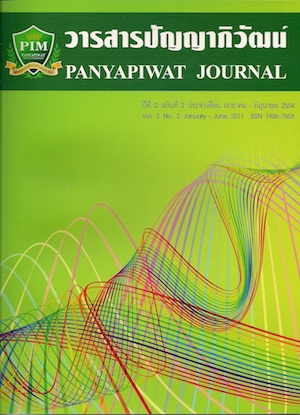คุณภาพชีวิตของคนไทย: นัยจากสถิติการฆ่าตัวตาย
Main Article Content
บทคัดย่อ
บทคัดย่อ
บทความเรื่องนี้มีวัตถุประสงค์เพื่อสะท้อนระดับคุณภาพชีวิตของคนไทยโดยการพิจารณาจากอัตราการฆ่าตัวตายของคนไทยในระดับประเทศ ภูมิภาค และจังหวัด ระหว่างปี พ.ศ.2547-2552 ซึ่งได้จากกรมสุขภาพจิต ผลการศึกษาพบว่า คุณภาพชีวิตของคนไทยในระดับประเทศยังอยู่ในระดับปานกลางแต่มีแนวโน้มเพิ่มขึ้นอย่างต่อเนื่อง ซึ่งเห็นได้จากการที่อัตราการฆ่าตัวตายของคนไทยลดลงอย่างต่อเนื่องในช่วงเวลาดังกล่าว เมื่อพิจารณาในระดับภูมิภาค พบว่าประชาชนในภาคเหนือต้องการการยกระดับคุณภาพชีวิตมากที่สุดจากการที่มีอัตราการฆ่าตัวตายสูงที่สุดในประเทศ สำหรับภาคใต้ แม้จะมีคุณภาพชีวิตสูงเป็นอันดับ 2 ของประเทศ แต่ก็เป็นภูมิภาคเดียวในประเทศที่ประชาชนมีคุณภาพชีวิตลดลงอย่างต่อเนื่อง ซึ่งก็ต้องการการแก้ไขอย่างเร่งด่วนเช่นเดียวกัน นอกจากนี้เมื่อพิจารณาในระดับจังหวัด พบว่าประชาชนในจังหวัดแม่ฮ่องสอนต้องการการพัฒนาเพื่อยกระดับคุณภาพชีวิตมากที่สุด เนื่องจากมีอัตราการฆ่าตัวตายสูงสุดเป็นอันดับที่ 4 ของประเทศ และมีการเพิ่มขึ้นของอัตราการฆ่าตัวตายสูงที่สุดในประเทศอีกด้วย
คำสำคัญ : คุณภาพชีวิต, ความอยู่ดีมีสุข, การพัฒนาเศรษฐกิจและสังคม, สถิติการฆ่าตัวตาย
Abstract
This article aims to study the living quality of Thai people through examining the suicide rate statistics of Thai people at the national, regional and provincial levels from 2004 to 2009 obtained from the Department of Mental Health. The findings reveal that the living quality of Thai people in general, though currently sitting at mediocre level, is continuously improving. An evidence supporting this fact is a steady decline of suicide rates over the period. In term of regional level, people in the North are in need of living quality improvement the most given that their suicide rates ranking highest in the country. Although people in the South have the second highest quality of living, their quality of life has become worsening and they are the only group experiencing such down trend. This problem also requires an immediate solution. In term of provincial level, people in Mae Hong Son are in need of better living quality the most since their suicide rate rank fourth in the country and it has been increasing at the fastest pace compared to those of other provinces.
Keywords : Quality of Life, Well-Being, Economic and Social Development, Suicide Statistics
Article Details
“ข้าพเจ้าและผู้เขียนร่วม (ถ้ามี) ขอรับรองว่า บทความที่เสนอมานี้ยังไม่เคยได้รับการตีพิมพ์และไม่ได้อยู่ระหว่างกระบวนการพิจารณาลงตีพิมพ์ในวารสารหรือแหล่งเผยแพร่อื่นใด ข้าพเจ้าและผู้เขียนร่วมยอมรับหลักเกณฑ์การพิจารณาต้นฉบับ ทั้งยินยอมให้กองบรรณาธิการมีสิทธิ์พิจารณาและตรวจแก้ต้นฉบับได้ตามที่เห็นสมควร พร้อมนี้ขอมอบลิขสิทธิ์บทความที่ได้รับการตีพิมพ์ให้แก่สถาบันการจัดการปัญญาภิวัฒน์หากมีการฟ้องร้องเรื่องการละเมิดลิขสิทธิ์เกี่ยวกับภาพ กราฟ ข้อความส่วนใดส่วนหนึ่งและ/หรือข้อคิดเห็นที่ปรากฏในบทความข้าพเจ้าและผู้เขียนร่วมยินยอมรับผิดชอบแต่เพียงฝ่ายเดียว”
เอกสารอ้างอิง
กรมสุขภาพจิต. (2553). รายงานอัตราการฆ่าตัวตาย. สืบค้นเมื่อ 11 ตุลาคม 2553, จาก กรมสุขภาพจิต เว็บไซต์: http://www.dmh.go.th/plan/suicide/.
คณะกรรมการอำนวยการงานพัฒนาคุณภาพชีวิตของประชาชนในชนบท. (2540). รายงานคุณภาพชีวิตของคนไทย ปี 2539. กรุงเทพฯ: ศูนย์ข้อมูลเพื่อการพัฒนาชนบท, กรมการพัฒนาชุมชนกระทรวงมหาดไทย.
ศูนย์ข้อมูลเพื่อการพัฒนาชนบท. (2553). ข้อมูลความจำเป็นพื้นฐาน. สืบค้นเมื่อ 7 พฤศจิกายน 2553, จาก ศูนย์ข้อมูลเพื่อการพัฒนาชนบท เว็บไซต์: http://61.19.244.12/rdic/sys_jbt.php
สาลินี เทพสุวรรณ์, รศรินทร์ เกรย์, เรวดี สุวรรณนพเก้า และ ภูวไนย พุ่มไทรทอง. (2550). ดัชนีความอยู่ดีมีสุขมวลรวมของคนไทย: ความสำคัญของภาคประชาชน. เอกสารการประชุมวิชาการประชากร-ศาสตร์แห่งชาติ 2552, 22-23 พฤศจิกายน 2550. กรุงเทพ.
สำนักงานคณะกรรมการพัฒนาการเศรษฐกิจและสังคมแห่งชาติ. (2550). กรอบแนวคิด หลักเกณฑ์ และวิธีการวัดความอยู่ดีมีสุขของคนไทย. กรุงเทพฯ: สำนักงานคณะกรรมการพัฒนาการเศรษฐกิจและสังคมแห่งชาติ.
Bagolin, I. (2004). Human development index (HDI): A poor representation to human development approach. PhD. Dissertation, Federal University of Rio Grande de Sul, Brazil.
Daly, M.C., Oswald, A.J., Wilson, D. & Wu, S. (2010). The happiness-suicide paradox. San Francisco: Federal Reserve Bank of San Francisco.(Working Paper, No. 2010-30)
Economist Intelligence Unit. (2005). The economist intelligence unit’s quality of life index. New York: Economist Intelligence Unit.
Ford, J.M. & Kaserman, D.L. (2000). Suicide as an Indicator of quality of life: Evidence from dialysis patients. Contemporary Economic Policy, 18(4), 440-448.
Larson, D.A. & Wilford, W.T. (1979). The physical quality of life index: A useful Social Indicator? World Development,7(6), 581-584.
Marks, N., Abdallah, S., Simms, A. & Thomson, S. (2006). The happy planet index: An index of human well-being and environmental impact. London: New Economics Foundation.
McGillivray, M. (1992). Measuring development: A statistical critiques of the UNDP’s human development index. The Hague: Institute of Social Studies. (Working Paper Series, No. 135)
Mofidi, N., Ghazinour, M., Araste, M., Jacobson, L. & Richter, J. (2008). General mental health, quality of life and suicide-related attitudes among Kurdish People in Iran. International Journal of Social Psychiatry,54(5), 457-468.
Sagar, A.D. & Najam, A. (1998). The human development index: A critical review. Ecological Economics, 25, 249-264.
Savirasarid, N. (2008). The selected factors related to quality of life of elderly people in Bangkok. Master Degree Thesis, Faculty of Graduate Studies, Mahidol University, Thailand.
Streeten, P. (1995). Human development: The debate about the index. Social Science Journal, 47(1), 25-37.
Thompson, K. (1982). Emile Durkheim. London: Tavistock Publication.
UNDP. (2010a). Human development report 2010. New York: United Nations.
UNDP. (2010b). Human development reports: Global reports. Retrieved November 11, 2010, from United Nations Development Programme Website: http://hdr.undp.org/en/reports/global/
WHO. (1997). Measuring quality of life: The world health organization quality of life instruments. Geneva: World Health Organization.
WHO. (2010). Suicide prevention and special programmes. Retrieved May 2010, from WHO (World Health Organization) Website: http://www.who.int/mental_health/prevention/en/


